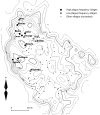Plague and the human flea, Tanzania
- PMID: 17553245
- PMCID: PMC2738476
- DOI: 10.3201/eid1305.061084
Plague and the human flea, Tanzania
Abstract
Domestic fleas were collected in 12 villages in the western Usambara Mountains in Tanzania. Of these, 7 are considered villages with high plague frequency, where human plague was recorded during at least 6 of the 17 plague seasons between 1986 and 2004. In the remaining 5 villages with low plague frequency, plague was either rare or unrecorded. Pulex irritans, known as the human flea, was the predominant flea species (72.4%) in houses. The density of P. irritans, but not of other domestic fleas, was significantly higher in villages with a higher plague frequency or incidence. Moreover, the P. irritans index was strongly positively correlated with plague frequency and with the logarithmically transformed plague incidence. These observations suggest that in Lushoto District human fleas may play a role in plague epidemiology. These findings are of immediate public health relevance because they provide an indicator that can be surveyed to assess the risk for plague.
Figures


References
-
- World Health Organization. Human plague in 2002 and 2003. Wkly Epidemiol Rec. 2004;79:301–8. - PubMed
-
- World Health Organization. Outbreak news index 2005. Wkly Epidemiol Rec. 2005;80:433–40. - PubMed
-
- Kilonzo BS, Mhina JIK. Observations on the current status of plague-endemicity in the western Usambara mountains, north-east Tanzania. Acta Trop. 1983;40:365–73. - PubMed
MeSH terms
LinkOut - more resources
Full Text Sources
Medical
